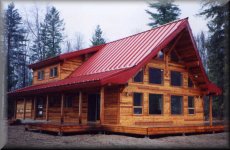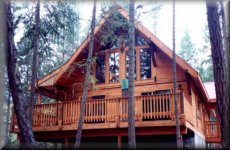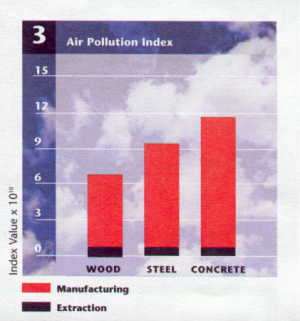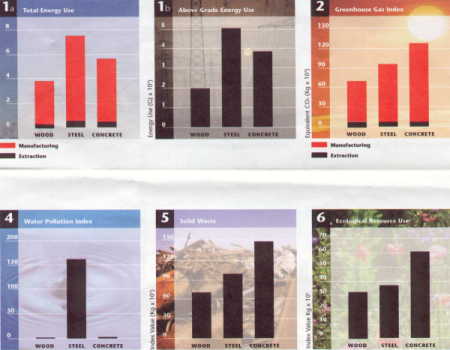








1. Energy Use |
| The Athena model calculates the energy use as the total of all forms of fuel used in the extraction, production, construction and transportation processes. The wood design has the lowest energy use of the three structures-concrete requires 1.5 times the energy, steel 1.9 times the energy of the wood building. If the above-ground structure alone is considered (that is, the concrete underground parking lot is eliminated), then concrete requires 1.7 times and steel requires 2.4 times more energy than wood does. |
2. Greenhouse Gas |
| Greenhouse gas emissions are largely a function of energy use. However, even though the concrete design used less energy than steel, it actually produced more greenhouse gases due to the large amount of CO2 released during cement manufacture. The wood building had the lowest greenhouse gas emissions-steel generated 1.45 times more; concrete 1.81 times more. |
3. Air Pollution |
| This index compares the toxicity or health effects of substances resulting from energy use and production process. These included sulfur oxides, suspended particulate matter and carbon monoxide. The wood design had the lowest pollution index, with the steel and concrete designs producing 1.42 times and 1.67 times more air pollution than wood. |
4. Water Pollution |
| Liquid wastes include those which are nutrients, produce sediment, deplete oxygen, and contain toxic organics and metals. The steel manufacturing process has a considerable impact on water quality. Once again, wood had the lowest pollution index rating, with steel generating 120 times and concrete 1.9 times more water pollution than wood. |
5. Solid Waste |
| For this study, solid waste by-products were defined as those which have no purpose in the manufacturing and installation process and must be indefinitely stored or land-filled. The manufacture of wood products is very efficient and produces very little waste that cannot be used for other products. The wood design had the lowest solid waste by-products, with the steel design 1.36 times and the concrete design 1.96 times higher than the wood option. |
6. Ecological Resource Use |
| Unlike the other indices, the impact of extracting resources is complex and difficult to quantify. Athena's approach is based on a survey of numerous resource extraction and environmental specialists from across Canada. Relative to mining and quarrying, forest harvesting exacted a larger per unit impact on the environment. However, due to the large quantity of raw material needed to construct steel and concrete designs, the wood design achieved the lowest overall ecological resource rating-steel and concrete designs were 1.16 and 1.97 times higher. |
Any Way you look at it, Wood is Good! |
|
In whatever category you look-whether it's the amount of pollution produced from manufacturing it, the amount of energy used in producing it, right down to its disposal as a biodegradable product-in all the different phases of a product's life cycle, wood wins hands down. It's also renewable-the only resource you can keep on growing." That's Kelly McCloskey speaking. As president of the Canadian Wood Council he is well-versed in research documenting the environmental impact of wood, particularly the Athena model. This computer-based tool was developed by Forintek Canada, the research arm of the wood industry, in conjunction with researchers from the steel, concrete and wood industries, as well as universities. The result was a cross-industry comparison of three building material systems: wood, steel and concrete. It analyzed the raw materials and energy used, as well as emissions to air, water and land, for a three-storey office building, constructed using each of these systems (each model also had a concrete underground parking lot). The conclusion: wood has the lowest environmental impact for all the factors considered.
|